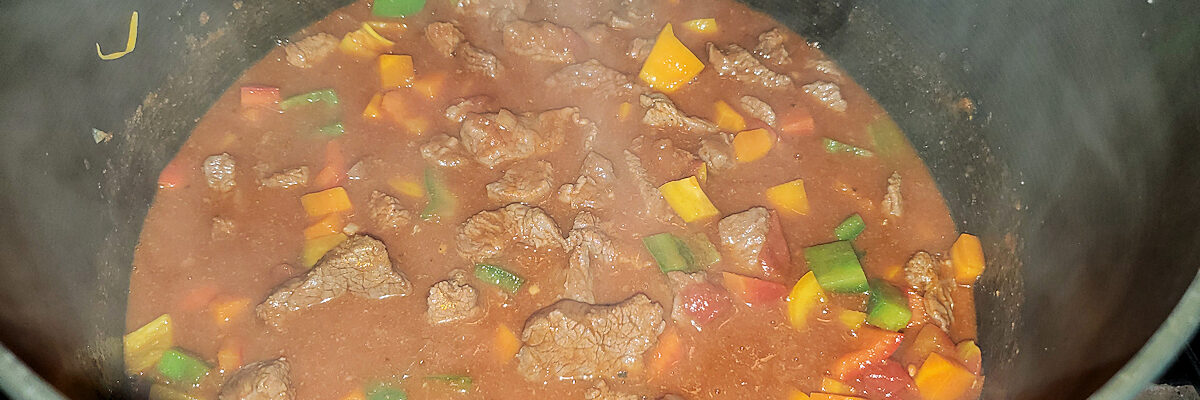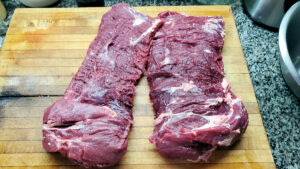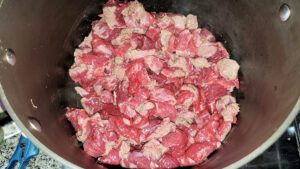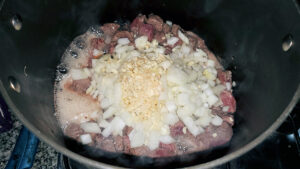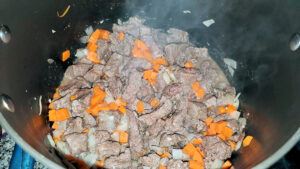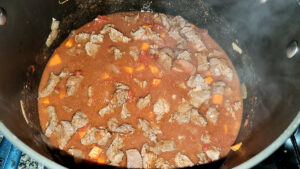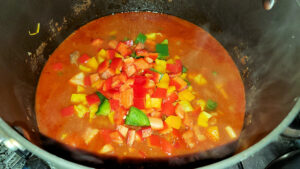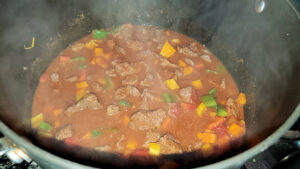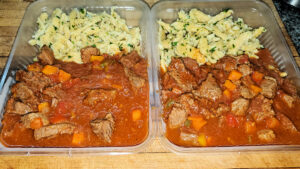“The invention of goulash began with one of the humblest groups in Hungarian society, the cowherds, according to the distinguished Hungarian ethnologist Eszter Kisbán. Groups of five or six single men, with their dogs and a couple of horses to pull their supply cart, spent months or even a year at a time out on the plains tending tall, slender gray cattle with long upturned horns. They cooked for themselves in large cauldrons slung from a pole supported by posts over an open fire, using simple, nonperishable supplies: millet, lard, bacon, onions, salt, and sometimes black pepper. If one of the cattle died or was slaughtered, the cowherds would feast on a rare dish of fresh meat, a simple stew made by browning the meat in lard and onions, adding water and, if available, black pepper. At some point, they began substituting coarsely ground dried red chilies from home gardens for the pepper. In the villages, some unknown innovator had rediscovered what was already known in the Americas, that chilies could be dried, crushed underfoot, and pounded in a mortar. By the end of the 18th century, travelers were commenting on this rough, spicy peasant dish that left a pleasant warmth in the stomach. Since the Hungarian term for herdsmen was gulyás, the travelers called this herdsmen’s meat, or gulyás hús.” – Smithsonian Magazine
Goulash. You’ve all heard of it. Some of you have eaten it. I don’t recall the one that we, very occasionally, had when I was growing up being all that special. As a guess, good of a cook as my mom was, she probably used the recipe in The Joy of Cooking, easily her most used cookbook in the kitchen. That recipe calls for browning some stewing beef in vegetable oil, adding chopped onions, some stock (or canned tomato juice), chopped green peppers, salt, and sweet paprika, cooking it for an hour and a half, straining the solids out, and thickening up the cooking liquid with flour, recombining it with the meat, and serving it over noodles or polenta.
I’m sure that there are grandmothers in Hungary who would more or less make it that way, but my bet is, many would blanch in horror. I could be wrong. I’ve never been to Hungary. But if the recipes I’ve found over the years online, and the versions of the dish I’ve tried in Hungarian restaurants in the US and here in Argentina are anything to go on, I’m not. Over the years, I’ve tweaked and played and adjusted and all the rest, and this is now how I make it, whether Hungarian grandmas approve or not.
I start by trimming up the beef – here I’m using tapa de nalga, which in the US is known as the bottom rump, or rump roast, and in the UK and associated former colonial spots, silverside. I’ve trimmed off the extra fat, plus the silverskin, that tough membrane that’s usually on one side of this cut. Then I cut it into roughly 2cm cubes.
Brown the cubes in a deep pot, big enough to hold the whole stew obviously. I was working with just shy of 3 kilos – maybe 7 pounds. I used olive oil to brown it.
Add a decent amount of chopped onion (I used 2 very large ones) and garlic (about 6 large cloves for this quantity of beef) and cook for a few minutes more until they start to brown as well.
Add some chopped carrot – not a lot. For this quantity of beef I only used one large carrot. Another few minutes of cooking.
Okay – here’s most of the rest – a couple of chopped tomatoes and a carton of tomato puree (400gm), a couple of bay leaves or about a teaspoon of ground bay leaf, a tablespoon of caraway seeds, and, my own touch, the trifecta of paprikas – one tablespoon each of sweet, hot, and smoked, and, a tablespoon of salt. Just enough beef stock to barely cover. Bring to a simmer, cover the pot, and cook for an hour and a half.
Add one each, chopped red, green, and yellow bell pepper. Mix in, re-cover the pot, and cook another hour.
Taste, adjust salt if needed.
Serve with spaetzle, or, really, since we’re talking Hungarian, nokedlii, which are basically the same thing (generally somewhat shorter than spaetzle). Making those is for another post, another day – I’ll have to get Henry to film me making those, as it’s a process that’s too hard to do and take photos at the same time. The amount above gave me nine generous portions (these servings, with the nokedlii, weighed in at 700gm each, or a pound and a half of food.
